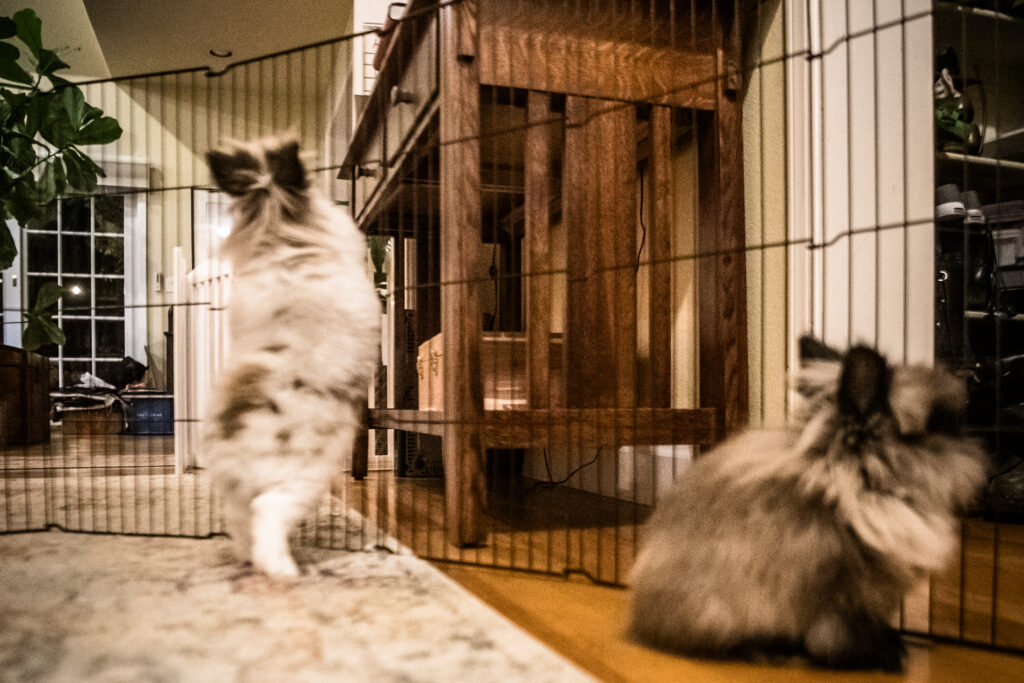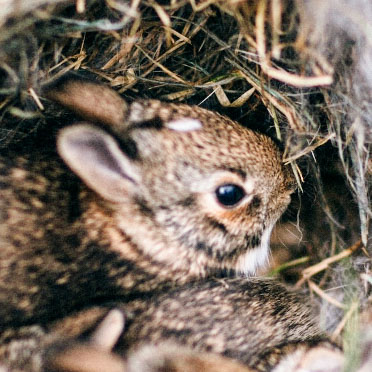YOU AND YOUR rabbit are living blissfully together, happy and seemingly safe. But it doesn’t take long for your bunny to get into trouble. As your bunny’s parent, being vigilant will ensure a safe, happy rabbit, one that may live to be 10 to 12 years old.
- Chewing the Wrong Things
Rabbits love to chew because their teeth are always growing. They do not discriminate on what they chew, however. You must make sure that he is not chewing on things that can cause illness or death. Electrical cords, if bitten completely through while plugged in, will kill a rabbit. Carpet, if ingested in substantial quantities, can cause serious blockages, even death. Plastic, shower curtains, etc., all have potentially serious effects and must be kept away from your bunny. Insulate electrical wires with wire covers, found in the hardware sections of your local home improvement store. Cover all carpeting (if he is chews carpet) with sea grass mats, or safe things to chew (such as hay). - Heat
Whether your rabbit stays indoors or outdoors, heat and heat stroke kill many bunnies each year. When temperatures rise over 85 degrees Fahrenheit, you must be home or have someone there to cool off the room and the bunny by turning on air conditioners, fans or using frozen water bottles. Never leave a rabbit in direct sunlight. Always stop home to check on him on hot days. Never use an aquarium for housing as there is not enough ventilation. Remember, he is wearing a fur coat all the time. - Improper Diet
You have heard of killing with kindness, and we all have been guilty of that to a degree with our pets. With rabbits, however, a steady diet of the wrong things (treats, pellets with nuts, fruits, no hay) will eventually cause digestive upsets and shorten a rabbit’s life. Rabbits need a substantial amount of hay (timothy, grass hay, oat hay), fresh greens and limited pellets as he gets older. Treats should be kept to a minimum. Rabbits that do not eat any hay have been known to only live a few years; they are often plagued by hairblocks, among other disorders. Try to find hay fresh, off-the-bale. - Bedding
Pine litter, cedar and clumping cat litter can be dangerous for your bunny. Pine and cedar give off “phenols,” which are caused by the processing of the wood. Over time, this odor can harm the liver. Clumping cat litter, if eaten, can cause serious blockages. It is best to stick with paper-type litter such as Carefresh®, Cat Country®, Yesterday’s News® or even straw on top of newspaper for his litter box. These paper litters and straw provide a soft resting area for your bunny as well. - Household Pets
The family dog or cat has killed many rabbits, indoors and outdoors. Never leave them together unsupervised. Always err on the side of caution, even if you believe your dog or cat would never hurt a fly. - Handling
Rabbits have very small bone structures compared to their body mass. Holding a bunny only by the scruff of the neck can result in a fractured back if the bunny tries to kick. Always support the rear legs when carrying your bunny, and never let young children pick up the rabbit. - Undetected Illnesses
Outdoor rabbits are more prone to contracting ailments (bladder stones, hairblocks, sniffles) that go unnoticed. Some of these, such as bladder stones and hairblocks, can be exceptionally painful for your bunny if not detected. Always keep your bunny close to you, and check on his eating habits and droppings regularly. If you see any change, be swift to call your rabbit veterinarian as rabbits can become ill and die very quickly. - Overpopulation
We all know the rabbit is the fertility symbol – and for good reason. A mature rabbit (doe) can have up to nine babies every 30 days with her male companion. These babies mature around 4 months, and they can also have babies. Doing the math, we have way too many rabbits and no homes. Spaying and neutering your bunny will prolong his/her life and prevent the all-too-common cancer associated with unaltered pets. Spaying/neutering can also save the lives of shelter bunnies, many of which are put to sleep each day due to the lack of homes. - Outdoors
This is one of the most dangerous places for a domestic bunny. Outdoor bunnies live shorter lives than indoor ones due to weather, risk of illness, heat, drafts and predators. Rabbits loose in yards are susceptible to poisonous plants, escaping into traffic or being caught by the neighborhood dogs, cats, wildlife or taken by others. - Predators
Rabbits are prey animals; that is, they are the ones preyed on by the carnivorous animals (raccoons, dogs, wolves, cats). Raccoons have been known to scare a rabbit to death just by crawling over his cage, never making contact. Your rabbit depends on you to keep him safe. Most outdoor cages are not adequate to protect a bunny from predators. If you can’t bring your rabbit indoors (the safest thing), make sure to have a double-enclosed cage, or put your bunny’s cage inside a barn or dog run at night, to thwart any attempt of predators from crawling over the cage, or from folks opening the cage and taking your bunny.
Following the above suggestions will ensure your bunny is as safe as possible, and you may find he lives up to 12 years, thanks to your love and diligence.
©Copyright Margie Wilson. All Rights Reserved. Republished with the permission of the author.

